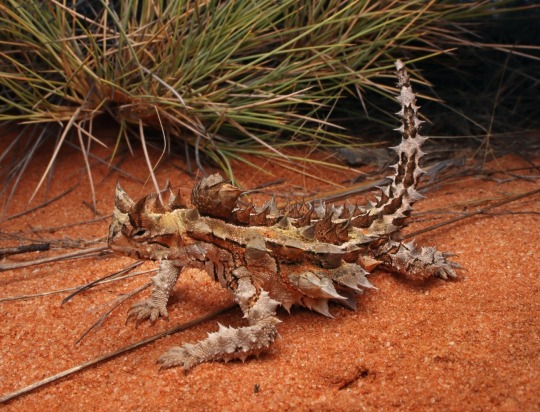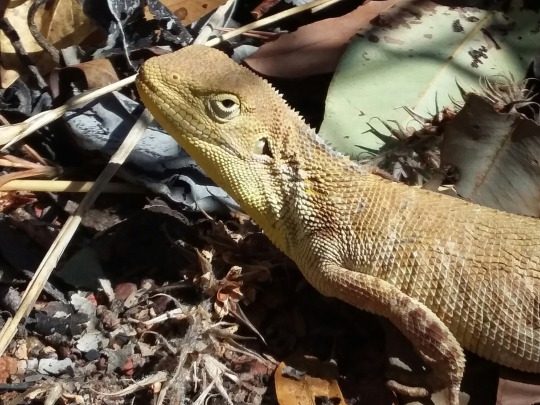#thorny devil lizard
Text
Uncharismatic Fact of the Day
Many desert animals have special adaptations that allow them to either find water in extremely dry areas or survive long periods without it. One of the more unusual adaptations is that of the thorny devil lizard. Its skin is covered in microscopic grooves which are able to draw water up out of the ground and transport it directly to the lizard's mouth via capillary action-- the same process that pulls water up into a paper towel.

(Image: A thorny devil (Moloch horridus) pausing for a drink by Christopher Watson)
If you like what I do, consider leaving a tip or buying me a ko-fi!
#thorny devil lizard#Squamata#Agamidae#dragon lizards#squamates#lizards#reptiles#uncharismatic facts
672 notes
·
View notes
Text


Thorny Devil (Moloch horridus), family Agamidae, South Australia
photographs by C. Margetts Photography
973 notes
·
View notes
Text

ACID REIGN
SALVATOR . SYBIL . JAKE . MARCUS
#scalie#crocodile#cobra#snake#frilled lizard#thorny devil#metal#punk furs#anthro#acid reign#salvator#Sybil#Jake#Marcus
372 notes
·
View notes
Text

Thorny devil (Moloch horridus)
Reptiles and Amphibians of the World. Written by Hans Hvass. Illustrated by Wilhelm Eigener. Originally published in 1958.
Internet Archive
236 notes
·
View notes
Text

Thorny devil
By: Unknown photographer
From: Disney’s Wonderful World of Knowledge
1971
81 notes
·
View notes
Photo



Thorny devil monkeys.
215 notes
·
View notes
Text






For all your lizard needs
#this is for all my fellow lizard girls <3#except for terfs. they have lost their lizard rights permanently.#in order of apperance: blue crested lizard. thorny devil. frilled lizard. basalisk lizard. gila monster. blue tongued skink
98 notes
·
View notes
Text
Protective GF

10 notes
·
View notes
Text
Everyone knows and loves thorny devils (Moloch horridus), spines and all, but I think most people are unaware of their peculiar and highly elusive sister species, the chameleon dragon (Chelosania brunnea).

(Image credit: The Reptile Database)
Named after their laterally compressed body, extendable dewlap and funnel-like eyes that give them some resemblance to the true chameleons of Afro-Eurasia, the chameleon dragon occurs widely in the monsoonal savanna woodlands of northern Australia in the Kimberley and Top End (as well as a tiny part of north-western Queensland). They are quite rarely observed and little is currently known about their ecology or behaviour, but this is likely due to their highly arboreal nature and they may actually be more common than records suggest.
At first glace, the chameleon dragon doesn't share a great deal of resemblance to the thorny devil, but some similarities begin to appear on closer examination. One of the most obvious links is their diet - thorny devils are well known for being specialised for feeding on small black ants, and the chameleon dragon, despite its drastically different appearance and lifestyle, appears to have a similar diet. While a lot less is known about the diet of chameleon dragons, they may also be ant specialists and have been recorded feeding on green ants (Oecophylla smaragdina), a species that is particularly common in the treetops they inhabit.


(Image credit: Colin Trainor & Gunter Maywald)
As a matter of fact, genetics indicate that the thorny devil and chameleon dragon are not only each other's closest living relatives, but also that they form their own distinct clade amongst Australian dryland agamids. The majority of Australian dragons are part of a single evolutionary radiation that diversified as the continent began to dry out in the mid-Miocene, with most exceptions being basal wet forest genera like forest dragons (Lophosaurus) and the Australian water dragon (Intellagama lesueurii). However, the thorny devil and chameleon dragon appear to be the only living members of a more ancient, basal agamid lineage that colonised dry environments independently of the recent large radiation.
As a testament to how much we still have to learn about this fascinating species, it was only in 2020 that a study (linked in the image credit below) found significant sexual dimorphism in regards to colour in chameleon dragons, with males being grey while females are yellow. This same study also published the first evidence of the species using tree hollows and the nests of arboreal termites as shelter sites. Due to the lack of data they are currently considered Data Deficient by the IUCN, but they may be threatened by altered fire regimes and feral cats.

Males above, females below
(Image credit: Laive & Jolly 2020)
Gonna be posting infodumps like this on Australian/Oceanian species I feel compelled to share fun facts on for whatever reason
#australian wildlife#wildlife#reptiles#lizards#agamidae#thorny devil#chameleon dragon#animal facts#herpetology#natural history#infodumps#my stuff
18 notes
·
View notes
Text

🟪 ANIMAL OF THE DAY: thorny devil. Moloch horridus. an Australian desert lizard that is very pokey. it also has a false head on its Shoulders, much like your average Content Creator, to protect it from Predators
#lizard#lizards#thorny devil#moloch horridus#reptile#reptiles#animal#animals#wildlife#nature#wild#aesthetic#bear of the ice
24 notes
·
View notes
Text


posting old demon specbio to celebrate monster roadtrip✨
1st image is just ur average demon and 2nd is THE damien lavey (+clothes test)
only the largest 2 horns on their head are true bony horns, the rest are modified scales!
#this wassss kinda just fucking around and finding out . also only technically one genus of demon#i had a whole worldbuilding thing laid out for Hell but i cant remember it all auwhjs#clearly inspired a lot by thorny devil lizards#and i do not resist the urge to make literally everything a biquad#the quad posture looks a little awkward .. hes just in a fighting stance#they r ambush predators if u even CAREE#monster prom#damien lavey#specbio#speculative biology#at the time of scheduling this i havent even played roadtrip yet. its sitting in my steam library.. so lonely... but alas i am a busy man#art hell
18 notes
·
View notes
Text

Thorny Devil (Moloch horridus), family Agamidae, Australia
photograph by Dan Rumsey (@zookeeper_dan)
804 notes
·
View notes
Text

Grzimek's Animal Life Encyclopedia. Volume 6: Reptiles. Written by Bernard Grzimek. 1984.
1.) Moluccan sail-finned lizard (Hydrosaurus amboinensis)
2.) Common flying dragon (Draco volans)
3.) Australian water dragon (Intellagama lesueurii)
4.) Cophotis sumatrana
5.) North African spiny-tailed lizard (Uromastyx acanthinura)
6.) Oriental garden lizard (Calotes versicolor)
7.) Common agama (Agama agama)
8.) Eastern bearded dragon (Pogona barbata)
9.) Sunwatcher Agama (Phrynocephalus helioscopus)
10.) Thorny devil (Moloch horridus)
#reptiles#lizards#Moluccan sail-finned lizard#common flying dragon#australian water dragon#North African spiny-tailed lizard#oriental garden lizard#common agamas#bearded dragons#sunwatcher agamas#thorny devils
369 notes
·
View notes
Text

Thorny devil
By: Unknown photographer
From: Handbuch der Biologie der Wirbeltiere
1913
83 notes
·
View notes
Text
I wish I could shoot blood out of my eyes like those silly lizards
0 notes

